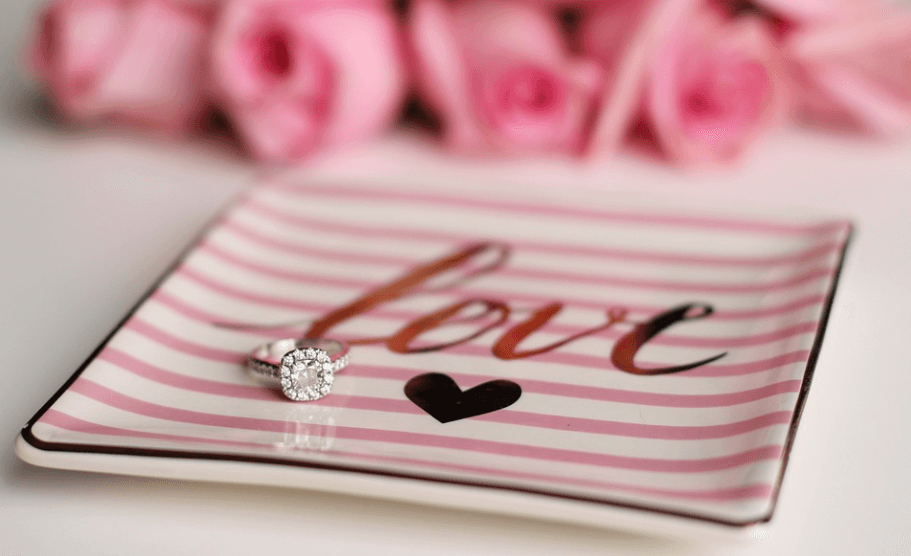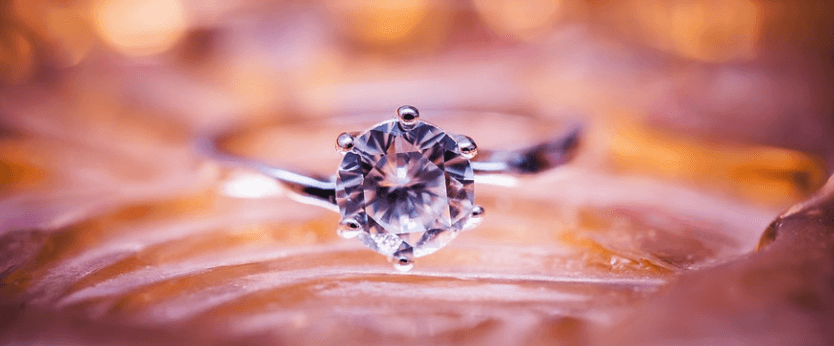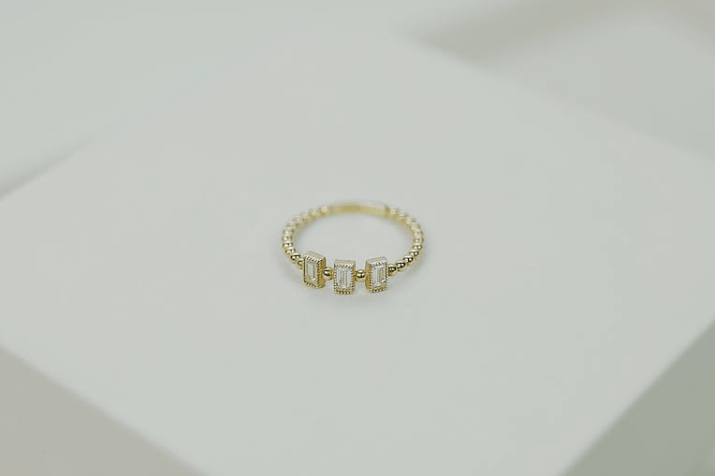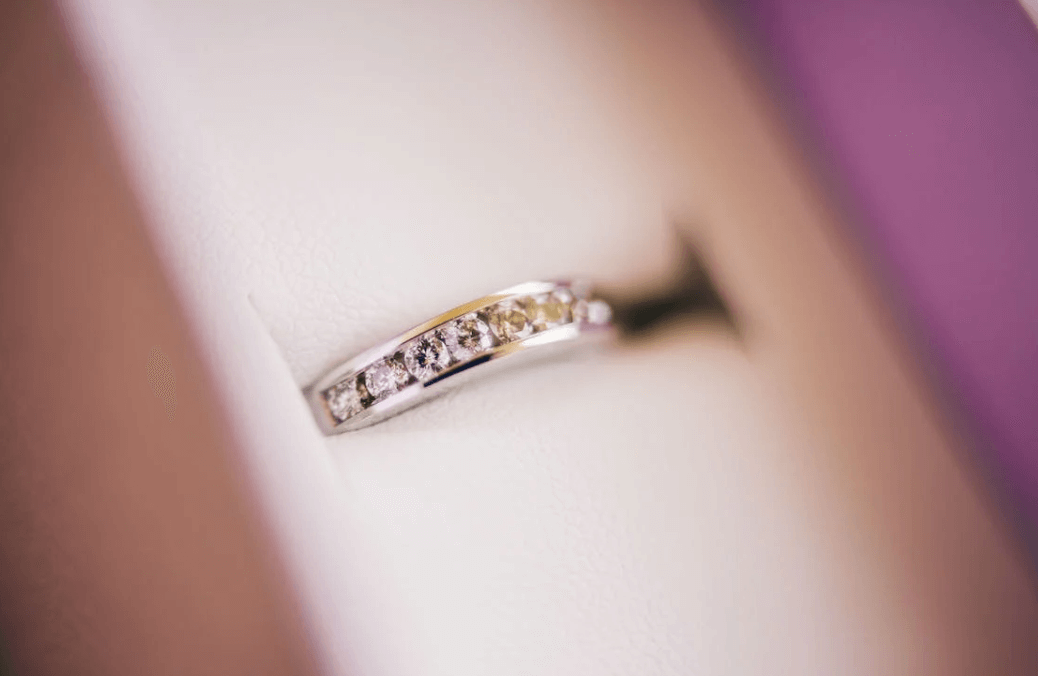What's the number one piece of advice you can give someone looking to buy an engagement ring? Have a budget in mind. Choosing an engagement ring can be overwhelming due to the variety of options available. Create a budget and stick to it. Providing your jeweller with some hard constraints will aid in the search for an engagement ring that fits your spending limit.
Does she already have a collection of jewellery? Is she more traditional or cutting-edge? Feminine or urbane? How about her jewellery—does she favour silver or gold? Do most of her works have a higher proportion of fineness to bulkiness? How about some ornateness, or keep it simple? Keep these preferences in mind as you shop for an engagement ring. You cannot go wrong if you buy her something that is very similar to something she already likes.
Find out what size ring she wears. Essentially, this is where one begins when searching for an engagement ring. If she likes to wear rings, just borrow one of hers. Draw a circle on the paper, or make an impression of the ring in a bar of soap. You can also draw a line by sliding it down one finger. It is possible for a jeweller to estimate her ring size using these dimensions.
If she doesn't wear rings, use these guidelines to make an educated guess: If we assume that the 'typical' American woman is 5 feet 4 inches tall and weighs 140 pounds, then the typical American ring size is 6. Her ring size is probably between 4 1/2 and 5 1/2 if she is slim or bony. Her ring size is probably between 6 1/2 and 7 1/2 if she is heavier, larger-boned, or taller than average. Since reducing the size of a ring is much simpler than increasing it, it is best to purchase one that is slightly larger than you anticipate she will need.
Is it difficult to pinpoint her tastes? Think about purchasing a loose diamond. To avoid the uncomfortable situation of choosing an engagement ring that is more to your taste than hers, it is recommended that the diamond be selected first and the setting made later.
Find out which diamond cut she prefers. If she hasn't already given you a hint by expressing a preference (or showing admiration for someone else's engagement ring), here are a few things to think about when shopping for an engagement ring:
- She'll be donning her wedding band around the clock for the duration of your marriage. The item must be versatile enough to be worn with both casual and formal attire. If you are unsure of her shape preference, it is safest to go with the tried-and-true classics. They have stood the test of time because they continue to captivate the largest possible audience.
- Diamonds with fewer facets, like those cut in the emerald or rose shape, should have a higher Clarity.
- In multi-stone rings, certain shapes work better than others. Shapes like rounds, ovals, and marquises all do nicely. Obstacles are more likely if your body is pear or heart shaped.
- She may respond positively to a rectangular or square diamond, such as the Emerald Cut or Princess Cut, if she has a taste for sleek, contemporary furniture. If she prefers the conventional, a round form is safe bet. Unique cuts, such as Trilliant and Marquise, are favourites of the bohemian set.
Celebrate your love with an engagement ring Melbourne that reflects your unique style and personality - browse our selection today!
Choose the Right Diamond
Since there are so many diamonds available online, it can be difficult to narrow down your options and choose the perfect one. This is in stark contrast to a traditional jewellery store, where your options are much more limited. Take into account the following detailed diamond buying guide. There is no one-size-fits-all approach to finding a diamond, but this could serve as a guide.
- Determine the ideal diamond shape by asking the recipient what they prefer. A round or princess cut is a safe bet if you don't know and can't find out.
- Consider the recipient when deciding on a minimum carat weight. When one has their sights set on a one-carat diamond, anything less than that size will seem paltry in comparison.
- You should begin by selecting the highest quality diamond that meets the shape and carat weight minimums you established in steps 1 and 2, and then make the following trade-offs until you find a diamond that is within your budget:
- Reduce Clarity first. More advice on purchasing Clarity can be found below. Reduce to VS2 before making any other concessions.
- Colour should then be dimmed. For additional help, please refer to the colour-buying advice section below. Try to get as low as H before giving in elsewhere.
- At last, we can reduce the Cut. To learn more about how to make a smart purchase when purchasing a cut, read on. Drop as low as Highest quality for round diamonds, then good for fancy shapes.
- You may want to reduce the diamond's carat weight if the ones that meet your revised criteria are close to your budget but not quite there. Visually distinguishing a carat weight discrepancy of 10% or less is exceedingly challenging.
- If you find yourself still overspending after applying the aforementioned measures, try starting over with lower limits.
- First, go deeper, cut down on the Clarity. Take it as low as level SI1.
- The next step is to lessen the use of colour. As low as the letter J is acceptable. You can safely go down to K if you know the diamond will be set in yellow gold.
- At last, the Cut has been lowered. Tolerate grades as low as Fair for fancy shapes and Good for round diamonds.
- The next step, if any, if you're still over budget will be up to you and your specific circumstances.
- Consider settling for SI2 Clarity if the diamond you're after weighs less than one carat.
- Under 1.50 carats in a brilliant cut may allow for an L-M diamond colour when mounted in yellow gold.
- If the size of the diamond is the most important factor, a round or fancy cut Fair Cut could be an excellent choice.
- To get back within your budget, you can either aim for a lower minimum carat weight or raise your budget.
Send us a request for a diamond price quote and be as specific as possible about your needs. We'll get back to you with some recommendations that meet your needs.
Ways to Pick the Perfect Wedding Ring
Now that you have the engagement ring (after some subtle hints, of course), it's time to find the perfect wedding ring to complement it, and we're here to help. Check out our comprehensive guide on all the things to think about before you say "I do" to the perfect wedding ring.
1. Narrow Down Your Wedding Ring Choices
Don't freak out if the prospect of choosing between diamonds and gemstones or platinum and gold for an engagement ring seems daunting. Don't panic; take things slowly. It's all about making a good first impression: Do you see a plain band, or do you want it to have some adornments? Would you prefer that your wedding ring match the metal of your engagement ring? Should you and your partner get matching rings? Answering these kinds of questions will help you focus your search and find exactly what you need.
2. Consider Buying Your Ring and Your Bands Together
While this won't work if you'd rather be surprised by the ring itself, it can help you decide on a wedding band by showing you what other options she has. If your engagement ring is particularly elaborate, you may prefer a plain band, while an understated ring may benefit from the glimmer of a diamond pavé band. Likewise, consider the interlocking nature of the rings. Getting a contour or shadow band that fits snugly next to your engagement ring is a great idea if you intend to wear both rings constantly. A more elaborate design that works well with or without an engagement ring is a good choice if you intend to wear your wedding band alone. You can discuss the possibility of a matching band with your jeweller (some can even create both at the same time).
3. Start Your Ring Search Early
Now that you have a rough idea of the type of ring you're interested in, you can start the fun part: trying them on! Shop for your wedding bands at least a couple of months before the big day. You'll want some time to look around, compare prices, and go back to stores with rings that caught your eye. You may need even more time if you have your heart set on a custom-made ring. Keep in mind that additional services like engraving can add up to a one-month wait time.
4. Mix It Up
If you prefer platinum, but your significant other prefers yellow gold, there's no need to worry. You're not restricted to using the same material or even the same design. Choosing wedding bands that reflect your styles is the key to finding something you both love. Braided bands that combine the two metals are one option for striking a compromise.
5. Set a Budget
When planning your wedding budget, keep in mind that the rings will likely account for 3 per cent of the total. A simple platinum or 14-karat gold band can cost you around $1,000. Adding embellishments to your rings, such as diamonds or engraving, can significantly increase the final price. Whether the engraving is done by hand or by machine, the number of characters, and the typeface all play a role in determining the final cost (hand is usually pricier).
6. Keep Your Lifestyle in Mind
Keep in mind that you intend to wear the band daily, so it should be something that blends in with your lifestyle. The "comfort fit" style of ring, which is narrower and has rounded edges, maybe the best option for people who play sports or instruments. If your job requires you to use your hands frequently, you may want to look for a plain metal ring without any carvings or gemstones. Platinum is the best choice if you lead an extremely active lifestyle because it is so scratch-resistant (the metal is merely displaced by the scratch).
7. Try Something Different
While a rose-gold braided band or a diamond eternity band might be high on your wish list, we recommend trying on a variety of rings in the store to find the one that best suits you. Talk to the jeweller, and then take all of their suggestions on board based on your likes and dislikes. The same is true of wedding gowns: you might surprise yourself by falling in love with an unexpected option. Do a comfort check by trying to write and text while wearing it around the store for a few minutes.
8. Think Long Term
You shouldn't be afraid to try new things, but you should make sure that whatever you decide to wear is a style you'll be happy with for at least the next 40 years. Don't worry too much, though; you're not tied down to that particular ring forever, and you can always customise it to celebrate future anniversaries by adding diamonds or switching to platinum.
9. Consider the Maintenance
Washing and soaking a wedding band with stones in warm, sudsy water, then gently brush it with a soft toothbrush or eyebrow brush (too much pressure can loosen the stones from their setting), rinse it, and patting it dry with a soft lint-free cloth, will keep it clean and sparkling. Maintenance sounds like too much work, right? A gold or platinum ring won't require much maintenance; just polish it with a lint-free cloth (chamois is ideal) every so often and it will look as good as new.
10. Size It Right
Most people wear their wedding bands all the time, even when their fingers swell or contract due to temperature changes, sweat, or pregnancy. Schedule your final ring fitting for a time when you are relaxed and your body temperature is stable for the most accurate results. For this reason, you shouldn't sign anything the moment you wake up (your fingers will swell from the water retention from the night before), immediately after you exercise (your fingers will swell from the blood flow boost), or when the temperature is too hot or too cold (which can cause your hands to expand and shrink).
11. Check for Quality
Every ring, not just your wedding bands, should be subject to quality control measures. Make sure the ring has a quality mark, like 24K or PLAT, and the manufacturer's trademark, which shows that the company will stand behind the product (this proves the metal quality is what the retailer says it is).
Conclusion
There is a multitude of engagement ring options out there, so it's important to set a budget and stick to it. Learn what size ring she wears so you can borrow one from her collection. If you can't tell if she wears rings by looking at them, you can use these guidelines to figure it out. It is recommended that the diamond be chosen first and the setting made afterwards to avoid the awkward situation of choosing an engagement ring that is more to your taste than hers. Buying a loose diamond may be the best option if you can't quite place her preferences.
Knowing her prefered diamond cut, finding a ring that can be worn with both casual and formal wear, and finding a diamond with a higher Clarity grade are the most crucial aspects of engagement ring shopping. Although there is no foolproof method for locating a diamond, the information below can help you make an informed purchase. Inquire about the recipient's preferences to determine the best diamond shape, think about them again when deciding on a minimum carat weight, choose the best diamond you can afford that fits the shape and weight requirements, and negotiate until you find one. Clarity should be lowered first, then colour, then cut, and finally, if the diamond is less than one carat in weight, SI2 clarity should be accepted. In order to get back on track financially, it may be necessary to reset your limits.
Content Summary
- Providing your jeweller with some hard constraints will aid in the search for an engagement ring that fits your spending limit.
- Does she already have a collection of jewellery?
- Keep these preferences in mind as you shop for an engagement ring.
- You cannot go wrong if you buy her something that is very similar to something she already likes.
- Find out what size ring she wears.
- If she likes to wear rings, just borrow one of hers.
- Draw a circle on the paper, or make an impression of the ring in a bar of soap.
- It is possible for a jeweller to estimate her ring size using these dimensions.
- Since reducing the size of a ring is much simpler than increasing it, it is best to purchase one that is slightly larger than you anticipate she will need.
- Is it difficult to pinpoint her tastes?
- Think about purchasing a loose diamond.
- Find out which diamond cut she prefers.
- If she hasn't already given you a hint by expressing a preference (or showing admiration for someone else's engagement ring),
- She'll be donning her wedding band around the clock for the duration of your marriage.
- The item must be versatile enough to be worn in both casual and formal attire.
- If you are unsure of her shape preference, it is safest to go with the tried-and-true classics.
- In multi-stone rings, certain shapes work better than others.
- Obstacles are more likely if your body is pear or heart-shaped.
- She may respond positively to a rectangular or square diamond, such as the Emerald Cut or Princess Cut, if she has a taste for sleek, contemporary furniture.
- If she prefers the conventional, a round form is a safe bet.
- Unique cuts, such as Trilliant and Marquise, are favourites of the bohemian set.
- Since there are so many diamonds available online, it can be difficult to narrow down your options and choose the perfect one.
- This is in stark contrast to a traditional jewellery store, where your options are much more limited.
- Take into account the following detailed diamond buying guide.
- There is no one-size-fits-all approach to finding a diamond, but this could serve as a guide.
- Determine the ideal diamond shape by asking the recipient what they prefer.
- Consider the recipient when deciding on a minimum carat weight.
- You should begin by selecting the highest quality diamond that meets the shape and carat weight minimums you established in steps 1 and 2, and then make the following trade-offs until you find a diamond that is within your budget.
- Reduce to VS2 before making any other concessions.
- To learn more about how to make a smart purchase when purchasing a cut, read on.
- Drop as low as Highest quality for round diamonds, then good for fancy shapes.
- You may want to reduce the diamond's carat weight if the ones that meet your revised criteria are close to your budget but not quite there.
- Visually distinguishing a carat weight discrepancy of 10% or less is exceedingly challenging.
- Tolerate grades as low as Fair for fancy shapes and Good for round diamonds.
- Consider settling for SI2 Clarity if the diamond you're after weighs less than one carat.
FAQs About Engagement Ring
The round brilliant cut is the most popular choice for an engagement ring. Its ability to bring out a diamond's brilliance and fire has earned it a place in jewellery history.
The cut describes the precision with which the diamond was cut to maximise its brilliance, while the shape describes its overall outline and proportions. The round cut is an example of a shape, while the round brilliant cut describes the way a diamond has been cut in order to maximise its brilliance.
The proportions, symmetry, and polish of the diamond are all aspects of its cut that contribute to its brilliance and fire. On the other hand, the weight of a diamond is measured in carats, with 1 carat equalling 0.2 grammes.
An individual's feelings and sense of style can be communicated through the form of their engagement ring. A diamond in the shape of a heart, for instance, is often used to symbolise undying love, but a diamond cut in the shape of a pear can convey a sense of sophistication and elegance.
Some engagement ring cuts do work better than others for various digit sizes and shapes. For instance, finger length can be emphasised with an oval or marquise cut, while broader fingers would look great with a round or cushion shape. However, the most crucial aspect of selecting a ring is the wearer's own taste.




